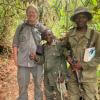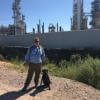Mass Detection of Wildlife Snares Using Airborne Synthetic Radar
For the last year my colleauges Prof. Mike Inggs (Radar - Electrical Engineering, Unviversity of Cape Town) and Kevin Gema (UCT Phd Candidate and Satellite radar developer for DragonFly Aerospace) have been working on trialing airborne Synthetic Aperture Radar for detection of snares.
We have completed 3-trials.
This technology offers the promise of flying at 120m above ground level at 135km an hour scanning a 1km wide area with 2mHz foliage penetrating radar locating all snares and gin traps to within a 1m and generating an alert in EarthRanger with the location, identity of target, and confidence % of assignment of identity of target.
Our hope is by doing this over entire conservation areas and allowing identification, location and removal of traps that this will change the economics of snaring, avoiding the costly (at all levels) punative action we are now forced to use.
This will save the lives of millions of wildlife lives, and address the greatest threat to conservation, especially the survival of top predators whose abscence in their former home range is primarliy due to snaring.
Attached are documents outlining our progress so far, why we have confidence in this approach, and what we need to go further.
We are appealing for any input and comments , criticisms or any insights on this approach to dealing with wildlife snaring.
The topic of radar for snare detection was first mentioned in Wildlabs in 2017, but there have been no postings since then.
We are hoping to find collaborators and open the discussion of detection of wildlife snares anew.
SARDetectionWildlifeSnares1Pager.pdf SARDetectionWildlifeSnaresNF.pdf ICCB2023DroneTalkHelloTomorrowV1.pdf7 January 2024 6:57am
The 1 pager is a short outline of the project.
The 8 pager is a rationale for the project and where we are
The ICCB2023 is a PDF of the Power Point Presentation I gave at ICCB in Kigali in July
7 January 2024 6:04pm
Very interesting project.
It sounds like one of the remaining challenges is analysing the resulting data & performing snare detection? Perhaps you could open this up as a challenge to the community - provide sample data files and answers (actual snare locations) and see what folks can come up in terms of analysis algorithms & software.
13 January 2024 7:24am
That is a really good idea. Going forward I this year we will do this I foresee being able to do this late February. We are hoping to get the funding for more trials that will generate training data sets. It would be great to open this to the greater community. How do I set this up as a challenge in Wildlabs.net?
13 January 2024 9:17am
We have a concern that snares deployed within a forest environment are a hazard and danger to our conservation detection dogs. At the moment, we train the dogs that when they smell a snare, they are to run back to the handler and sit as an alert. This technology deployed before the dog team enters an area would significantly reduce the risk.
Very interesting concept!









David Gaynor